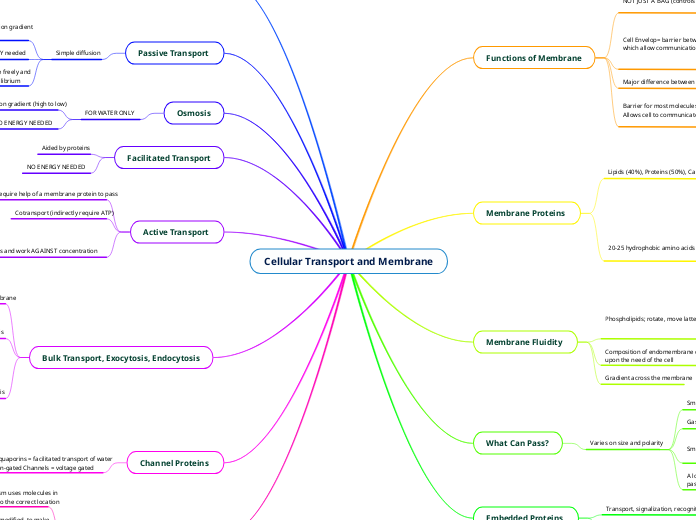Cellular Transport and Membrane
Functions of Membrane
Major difference between procaryotes and eukaryotes cells
Membrane Proteins
Lipids (40%), Proteins (50%), Carbohydrates (10%)
Important for Immune system
Carbohydrates are alone or attached to proteins
(glycoproteins) to lipids (glycolipids)
Consist of 20-25 monosaccharide units
Integral Proteins
proteins inside are hydrophobic
proteins exposed to cytoplasm or EXF are hydrophilic
Peripheral Proteins
found outside and inside surfaces of the membrane
(attached to integral protein or phospholipid)
Loosely attached!
Membrane Fluidity
Composition of endomembrane can change
upon the need of the cell
Gradient across the membrane
What Can Pass?
Varies on size and polarity
Small hydrophobic molecules CAN PASS
Gasses (O2,CO2,NO2) CAN PASS
A lot of (large) molecules need SPECIFIC TRANSPORTORS to pass membrane (proteins, amino acids, polysaccharides, DNA)
Embedded Proteins
Transport, signalization, recognition
Dynamic, aqueous environment, attach site for ECM
Types of Cellular Transport
Passive Transport, Active Transport, Bulk Transport
Stored, modified to make
macromolecules needed to
break down and produce
energy
Can exit, travel through vasculature system,
and enter or signal a different cell
Passive Transport
Simple diffusion
Follow concentration gradient
(from high to low)
NO ENERGY needed
Allowed to move freely and
will achieve equilibrium
Osmosis
FOR WATER ONLY
Follow concentration gradient (high to low)
NO ENERGY NEEDED
Facilitated Transport
Aided by proteins
NO ENERGY NEEDED
Active Transport
Require help of a membrane protein to pass
Cotransport (indirectly require ATP)
Involve carrier proteins and work AGAINST concentration gradient
Primary= uses direct source of energy
ion pumps important for cell membrane potential
Secondary = uses indirect source of energy,
CO2 transport (symporter or antiporter)
Bulk Transport, Exocytosis, Endocytosis
BOTH EXO and ENDOcytosis use the plasma membrane
Exocytosis
Used by secretory cells
(insulin release by pancreatic cells)
Used by neurons (neurotransmitters release)
Endocytosis
Phagocytosis = unicellular, immune cells
Pinocytosis= fluid intake (unicellular, intestinal cells)
Receptor Mediated Endocytosis = important for
cholesterol uptake
Channel Proteins
Aquaporins = facilitated transport of water
Ion-gated Channels = voltage gated
Functions of Cellular Transport
when the metabolism uses molecules in
order to transport to the correct location
stored, modified, to make
macromolecules needed to
break down and to produce
energy
Can exit, travel through vasculature
system, and enter or signal a
different cell
